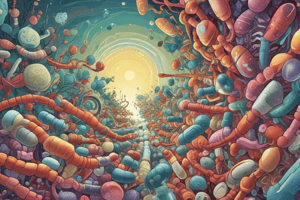Podcast
Questions and Answers
What is a notable adverse drug interaction exhibited by tetracycline?
What is a notable adverse drug interaction exhibited by tetracycline?
- Interaction with Warfarin
- Interaction with dairy, antacids, vitamins (correct)
- Interaction with oral contraceptives
- Interaction with alcohol, lithium
What is a potential adverse drug interaction of metronidazole?
What is a potential adverse drug interaction of metronidazole?
- Interaction with NSAIDS
- Interaction with Warfarin
- Interaction with alcohol, lithium (correct)
- Interaction with digoxin
What is a difficulty in determining drug-drug interaction risks?
What is a difficulty in determining drug-drug interaction risks?
- Unavailability of data on drug interactions
- Complexity of drug metabolism
- Variability in patient response
- All of the above (correct)
What is a potential adverse drug interaction of azithromycin or clarithromycin?
What is a potential adverse drug interaction of azithromycin or clarithromycin?
What is a potential adverse drug interaction of amoxicillin with Warfarin?
What is a potential adverse drug interaction of amoxicillin with Warfarin?
What is a mechanism of adverse drug interaction?
What is a mechanism of adverse drug interaction?
What is a potential adverse drug interaction of NSAIDs?
What is a potential adverse drug interaction of NSAIDs?
What is the potential consequence of co-administering epinephrine with tricyclic antidepressants (TCA's)?
What is the potential consequence of co-administering epinephrine with tricyclic antidepressants (TCA's)?
Which of the following drugs is most likely to displace a highly protein-bound drug from its binding site?
Which of the following drugs is most likely to displace a highly protein-bound drug from its binding site?
What is the primary mechanism of adverse drug interactions involving NSAIDs and lithium?
What is the primary mechanism of adverse drug interactions involving NSAIDs and lithium?
Which of the following antibiotics is most likely to interact with benzodiazepines?
Which of the following antibiotics is most likely to interact with benzodiazepines?
What is a common feature of drugs involved in adverse drug interactions?
What is a common feature of drugs involved in adverse drug interactions?
Which of the following drugs can interact with digoxin, leading to increased digoxin concentrations?
Which of the following drugs can interact with digoxin, leading to increased digoxin concentrations?
What is the potential consequence of co-administering benzodiazepines with opioids?
What is the potential consequence of co-administering benzodiazepines with opioids?
What is the mechanism of adverse drug interaction between NSAIDs and lithium?
What is the mechanism of adverse drug interaction between NSAIDs and lithium?
Which of the following antibiotics is likely to interact with benzodiazepines?
Which of the following antibiotics is likely to interact with benzodiazepines?
What is a common feature of drugs involved in adverse drug interactions?
What is a common feature of drugs involved in adverse drug interactions?
Which of the following drugs can interact with digoxin, leading to increased digoxin concentrations?
Which of the following drugs can interact with digoxin, leading to increased digoxin concentrations?
What is the potential consequence of co-administering benzodiazepines with opioids?
What is the potential consequence of co-administering benzodiazepines with opioids?
What is the primary mechanism by which azithromycin and clarithromycin interact with digoxin?
What is the primary mechanism by which azithromycin and clarithromycin interact with digoxin?
What is the primary mechanism by which metronidazole interacts with lithium?
What is the primary mechanism by which metronidazole interacts with lithium?
Which of the following drugs is most likely to interact with Warfarin?
Which of the following drugs is most likely to interact with Warfarin?
What is the primary mechanism by which NSAIDs interact with ethanol?
What is the primary mechanism by which NSAIDs interact with ethanol?
Which of the following antibiotics is most likely to interact with benzodiazepines?
Which of the following antibiotics is most likely to interact with benzodiazepines?
What is the primary mechanism by which epinephrine interacts with cocaine or methamphetamine?
What is the primary mechanism by which epinephrine interacts with cocaine or methamphetamine?
Which antibiotic is likely to exhibit an adverse drug interaction with Warfarin?
Which antibiotic is likely to exhibit an adverse drug interaction with Warfarin?
What is a potential adverse drug interaction of metronidazole with lithium?
What is a potential adverse drug interaction of metronidazole with lithium?
What is a potential adverse drug interaction of NSAIDs with ethanol?
What is a potential adverse drug interaction of NSAIDs with ethanol?
Which of the following antibiotics is likely to interact with digoxin?
Which of the following antibiotics is likely to interact with digoxin?
What is a potential adverse drug interaction of epinephrine with cocaine or methamphetamine?
What is a potential adverse drug interaction of epinephrine with cocaine or methamphetamine?
Which of the following NSAIDs is likely to interact with SSRIs?
Which of the following NSAIDs is likely to interact with SSRIs?
Which drug class is most likely to interact with macrolide antibiotics or protease inhibitors leading to inhibition of CYP3A4?
Which drug class is most likely to interact with macrolide antibiotics or protease inhibitors leading to inhibition of CYP3A4?
What is a common feature of drugs that are highly protein-bound?
What is a common feature of drugs that are highly protein-bound?
Which drug is most likely to interact with lithium, leading to increased lithium concentrations?
Which drug is most likely to interact with lithium, leading to increased lithium concentrations?
What is the primary mechanism of adverse drug interactions involving epinephrine and tricyclic antidepressants?
What is the primary mechanism of adverse drug interactions involving epinephrine and tricyclic antidepressants?
Which drug class is most likely to interact with antihistamines, leading to increased sedative effects?
Which drug class is most likely to interact with antihistamines, leading to increased sedative effects?
What is the primary mechanism of adverse drug interactions between benzodiazepines and macrolide antibiotics?
What is the primary mechanism of adverse drug interactions between benzodiazepines and macrolide antibiotics?
Which of the following drugs is most likely to displace warfarin from its binding site, leading to increased warfarin concentrations?
Which of the following drugs is most likely to displace warfarin from its binding site, leading to increased warfarin concentrations?
What is the primary mechanism of adverse drug interactions between NSAIDs and lithium?
What is the primary mechanism of adverse drug interactions between NSAIDs and lithium?
What is the primary mechanism of adverse drug interactions between epinephrine and tricyclic antidepressants?
What is the primary mechanism of adverse drug interactions between epinephrine and tricyclic antidepressants?
What is the primary mechanism by which NSAIDs interact with Warfarin?
What is the primary mechanism by which NSAIDs interact with Warfarin?
What is a common feature of drugs that are highly protein-bound?
What is a common feature of drugs that are highly protein-bound?
What is a common feature of drugs that are highly protein-bound?
What is a common feature of drugs that are highly protein-bound?
Which of the following antibiotics is most likely to interact with benzodiazepines, leading to increased sedative effects?
Which of the following antibiotics is most likely to interact with benzodiazepines, leading to increased sedative effects?
What is a potential adverse drug interaction of benzodiazepines with opioids?
What is a potential adverse drug interaction of benzodiazepines with opioids?
What is a common feature of drugs involved in adverse drug interactions?
What is a common feature of drugs involved in adverse drug interactions?
What is the primary mechanism of adverse drug interactions involving NSAIDs and ethanol?
What is the primary mechanism of adverse drug interactions involving NSAIDs and ethanol?
What is the mechanism by which azithromycin or clarithromycin interacts with digoxin, leading to increased digoxin concentrations?
What is the mechanism by which azithromycin or clarithromycin interacts with digoxin, leading to increased digoxin concentrations?
What is the primary mechanism of adverse drug interactions involving benzodiazepines and opioids?
What is the primary mechanism of adverse drug interactions involving benzodiazepines and opioids?
What is the mechanism by which epinephrine interacts with tricyclic antidepressants, leading to increased risk of hypertension?
What is the mechanism by which epinephrine interacts with tricyclic antidepressants, leading to increased risk of hypertension?
What is the primary mechanism of adverse drug interactions involving metronidazole and lithium?
What is the primary mechanism of adverse drug interactions involving metronidazole and lithium?
What is the mechanism by which tetracycline exhibits an adverse drug interaction?
What is the mechanism by which tetracycline exhibits an adverse drug interaction?
Flashcards are hidden until you start studying




